Learn how to easily roast butternut squash! Two methods are featured: how to roast a butternut squash whole, or cubed. You need just 4 simple ingredients, and the result is so easy and versatile! You can eat roasted butternut squash by itself, dip it into a sauce of your choice, or even use it to make butternut squash mac and cheese.

If you’ve been here for any length of time, you know that I love butternut squash and pumpkin! Especially during fall and winter, they’re one of my favorite ingredients to use in a whole range of recipes. You can keep them simple, or use to make a more intricate dish for a crowd-pleasing dinner.
Knowing how to roast butternut squash is an essential skill for any home cook. But if you love vegan cooking specifically, it’s even more important! Baked butternut squash is delicious by itself as a side dish or snack. But you can also use it to make everything from a ‘cheesy’ butternut squash sauce, to a comforting soup.

Today, I’ll be sharing my two favorite methods of roasting butternut squash: whole, and as cubes. Both are super easy to follow, and you will love the resulting seasonal deliciousness!
What’s to love about butternut squash?
Butternut squash is simply one of my favorite ingredients! It’s:
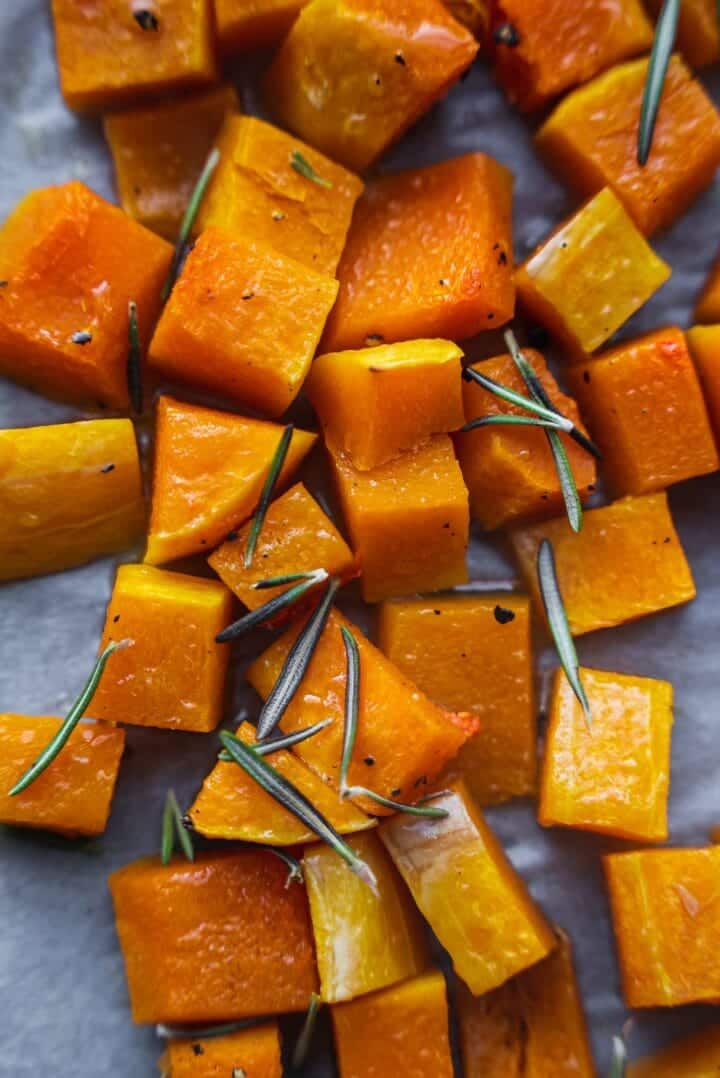
- Accessible and easy to find. It’s also a great alternative to pumpkin if your local supermarket doesn’t carry the latter. You can find it pretty much the whole year round too, not just during the colder seasons.
- Budget-friendly. In general, butternut squash is sold for a pretty affordable price.
- Incredibly delicious! Butternut squash has a naturally subtle sweet flavor, which also isn’t too overpowering. Even picky eaters will enjoy dishes involving butternut squash.
- Versatile. You can use it in a whole range of recipes, from soups and stews to vegan cheese sauces and even in desserts. Given that it’s a great alternative to baking pumpkin, you can also use it to make pumpkin purée if you can’t find canned pumpkin for pumpkin bread.
Ingredients you need
Roasting butternut squash requires just four simple ingredients. These are:
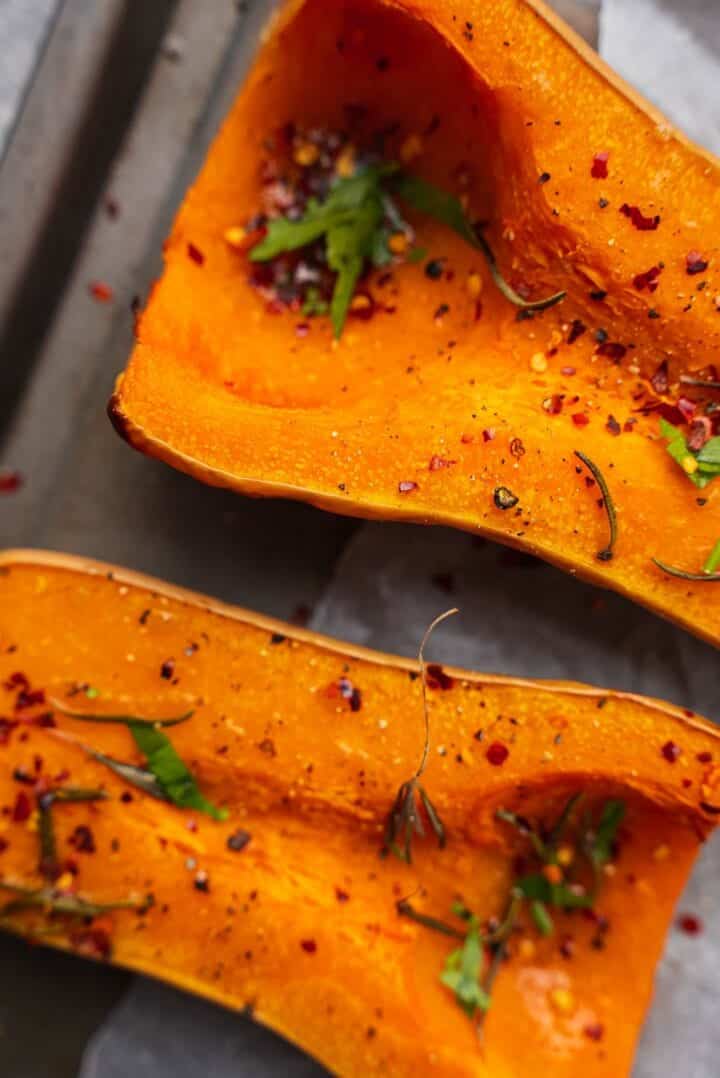
- Butternut squash. Try to pick a squash that is heavy for its size, as that’s a great indication of ripeness.
- Olive oil. This helps to give the baked butternut squash an incredibly rich and deep flavor. You can also use any other neutral oil of your choice. I wouldn’t recommend using coconut oil because the flavor is too strong.
- Salt and pepper. You can adjust the amount you use according to taste, and add more at the end right before serving.
How to roast butternut squash whole
This is the easiest method of baking butternut squash and requires very little work. No peeling needed!
Start by preheating a conventional oven to 350 degrees F/400 degrees C and line a large baking tray with parchment paper.
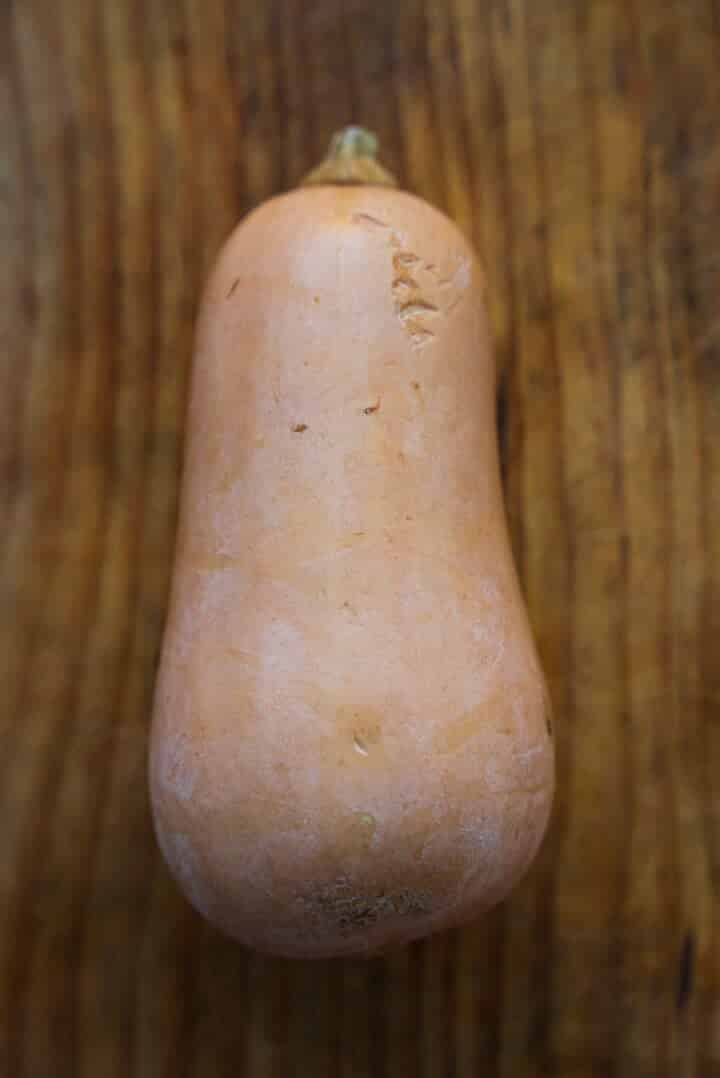
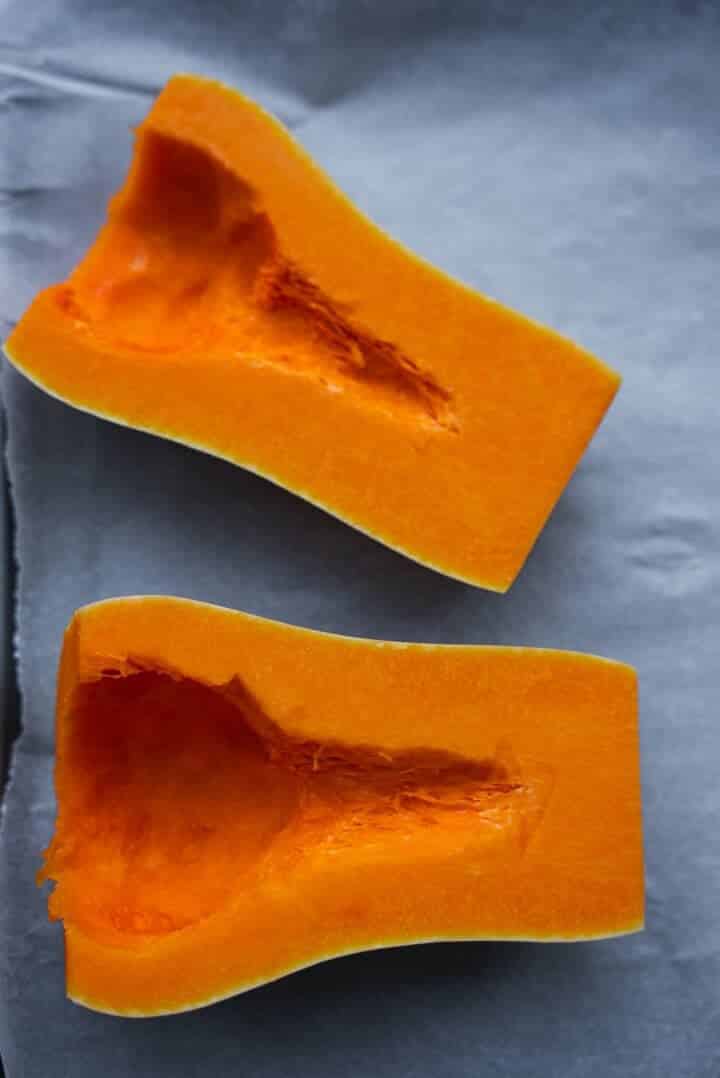
Next, cut the butternut squash in half. You can remove the top and bottom to make this easier. Next, scoop out the seeds and discard them, or save them for roasting.
Now lay the butternut squash flat side up on the baking tray. Drizzle with olive oil, and season generously with salt and pepper.
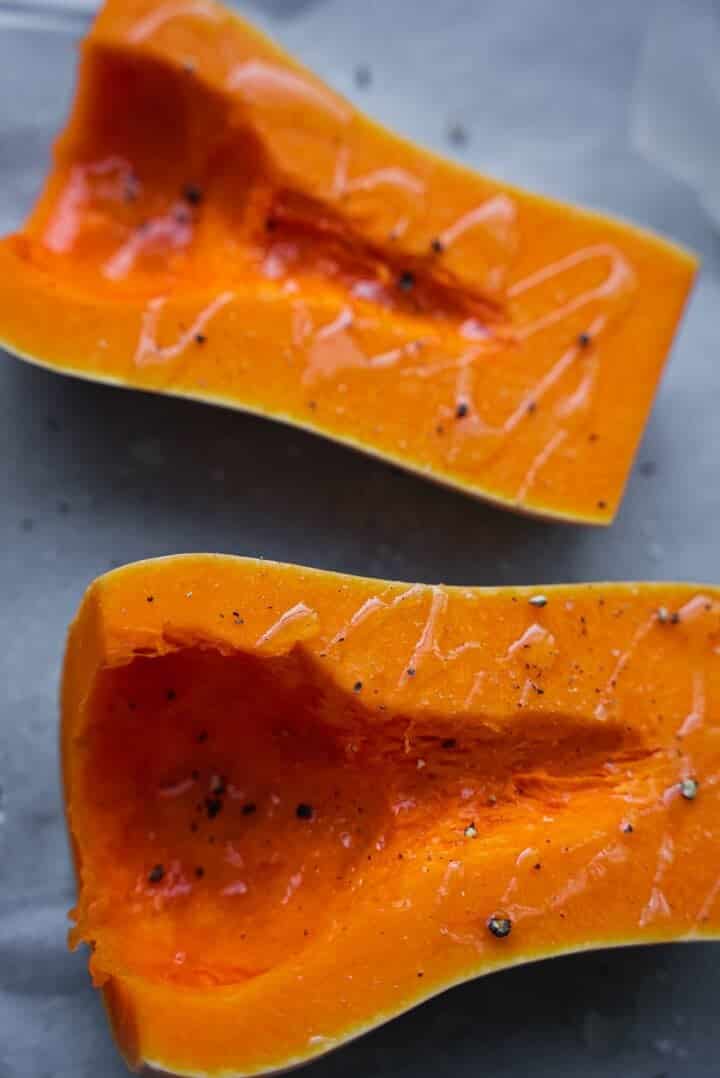
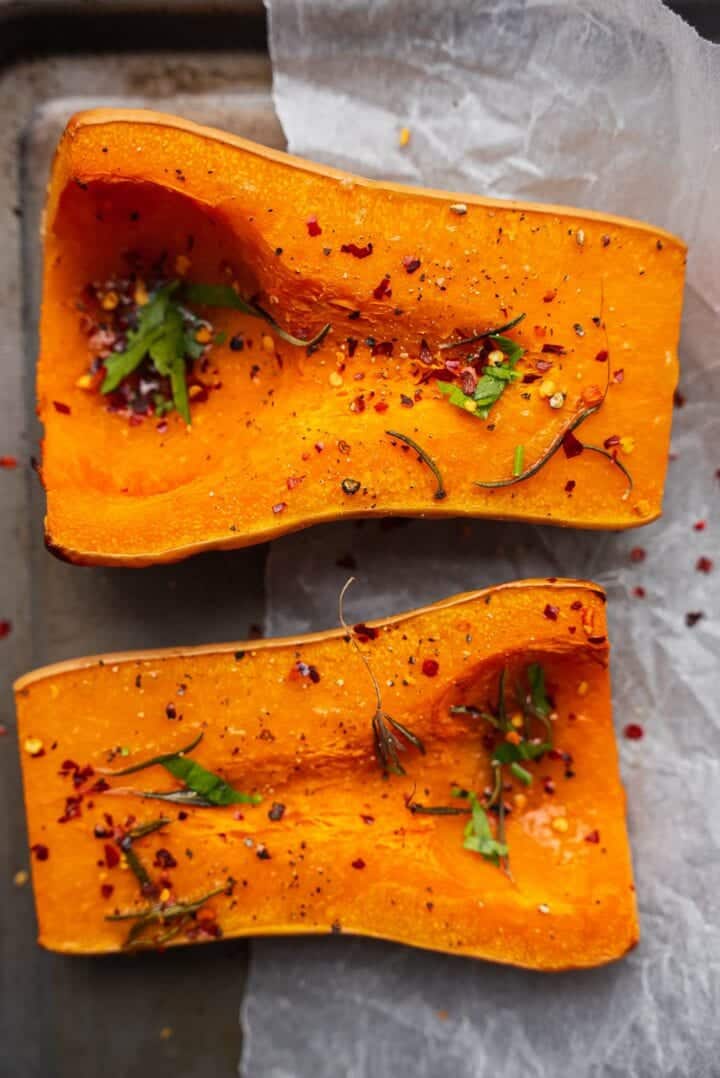
Bake for 50 minutes in the preheated oven, until fully fork tender. Around half way through the baking process, I like to add some fresh rosemary. You can then go ahead and serve, seasoning with extra salt and pepper if you wish.
How to roast butternut squash cubes
This method requires a little bit more work, but it’s the best option if you plan on using the roasted butternut squash in another recipe.
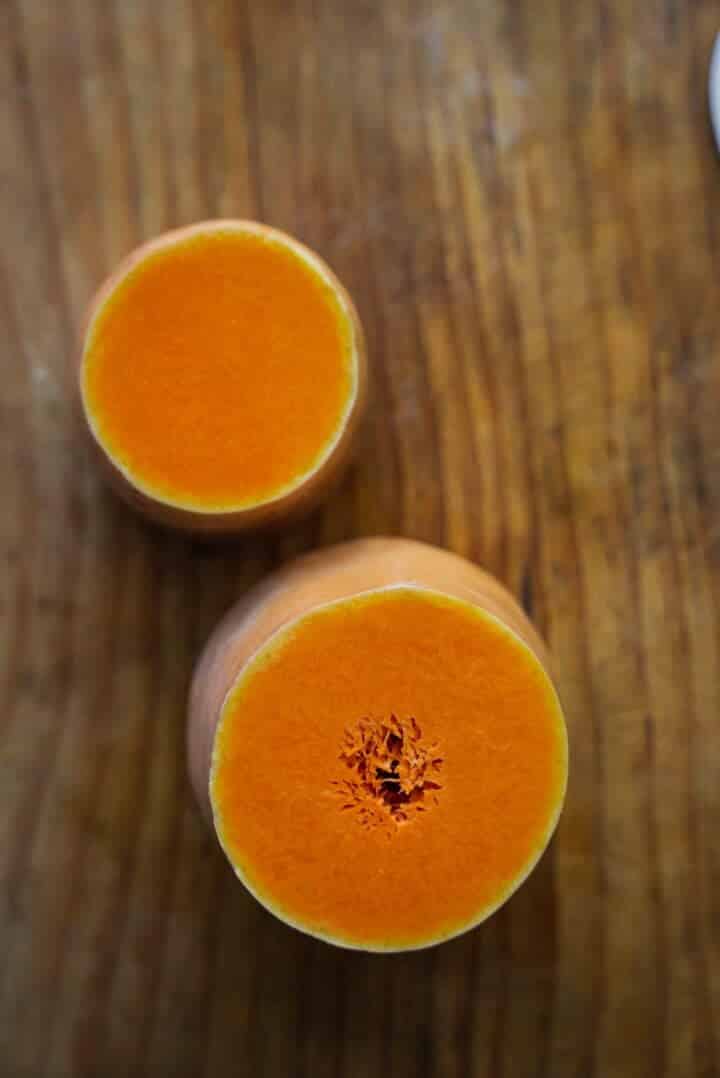
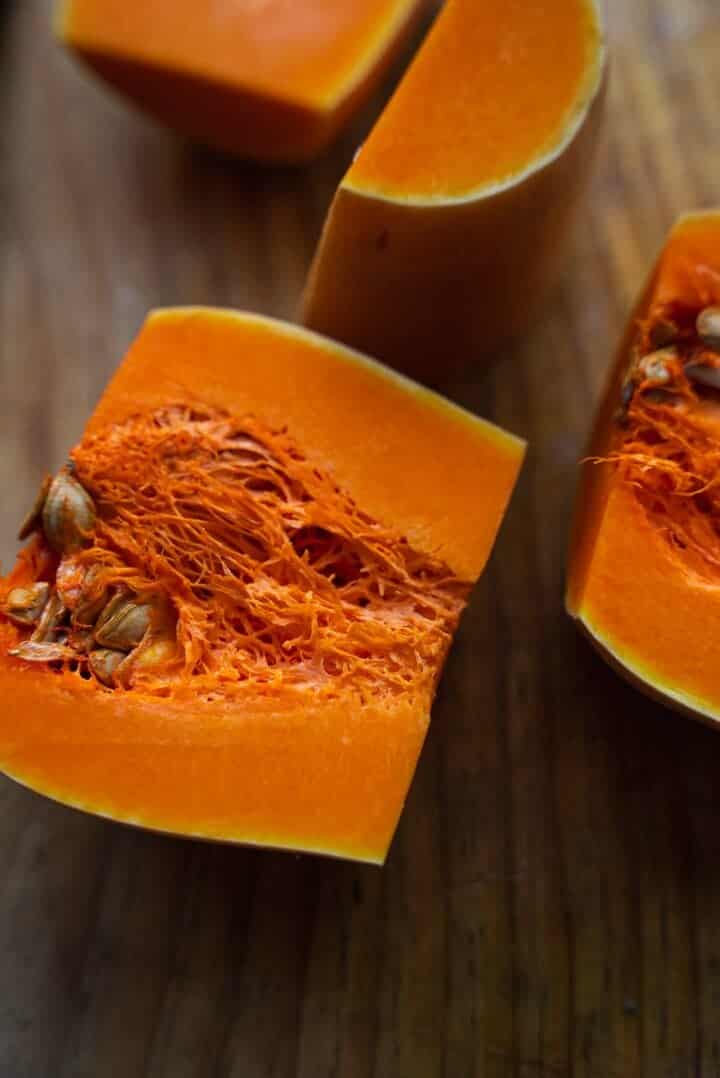
As above, start by preheating a conventional oven to 350 degrees F/400 degrees C and lining a large baking tray with parchment paper
Now remove the top and bottom off the butternut squash. Next, cut it in half horizontally, and then one again vertically.
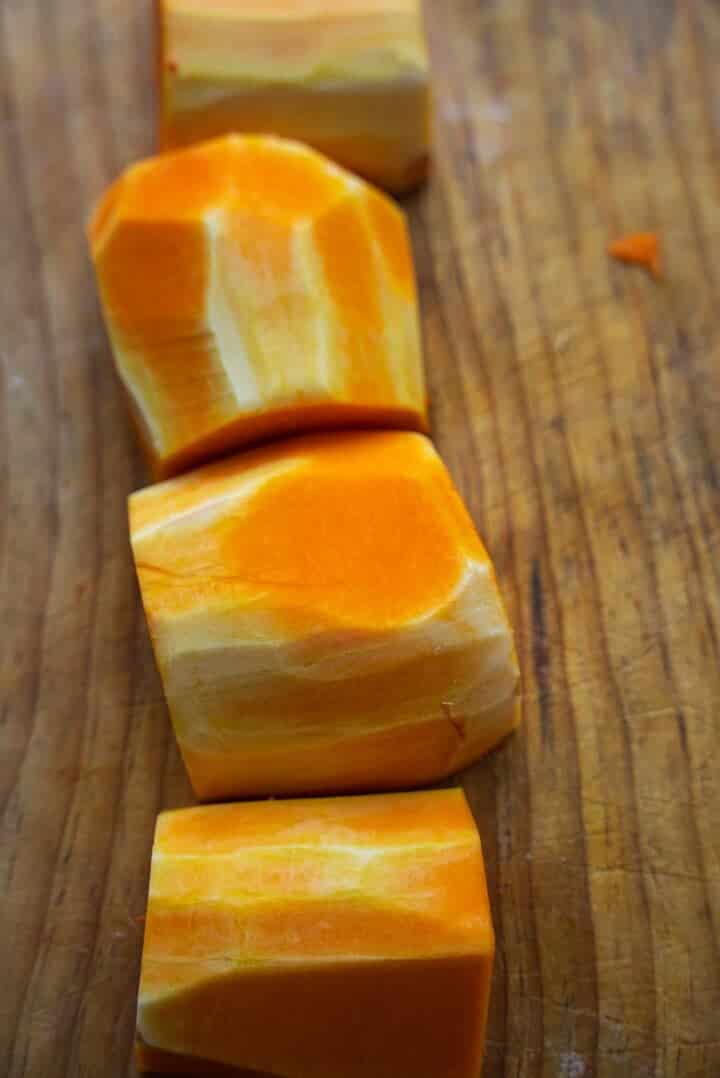
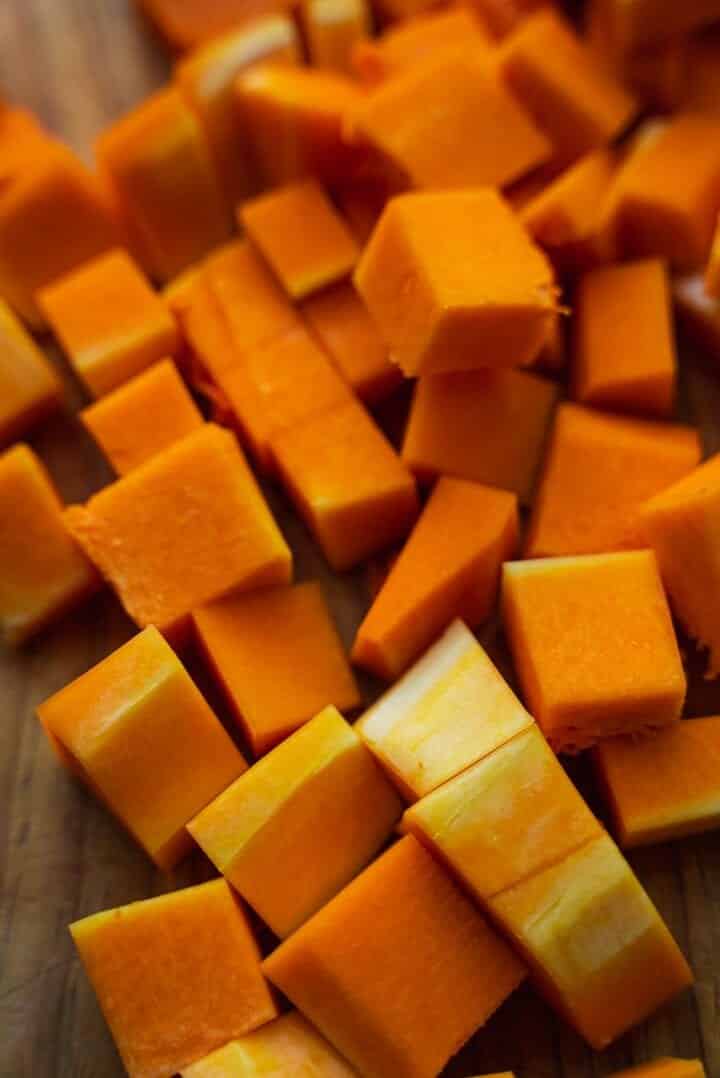
Remove the seeds from the bottom half of the butternut squash, and discard/save them. You can now go ahead and use either a knife or a vegetable peeler to peel the butternut squash. If you plan to serve the butternut squash cubes by themselves rather than, for instance, blending them into a sauce, you can also skip the peeling part.
Next, lay each section flat side down, and cut it lengthwise into rectangles. Then, turn them around and cut at a 90 degree angle to make the butternut squash cubes.
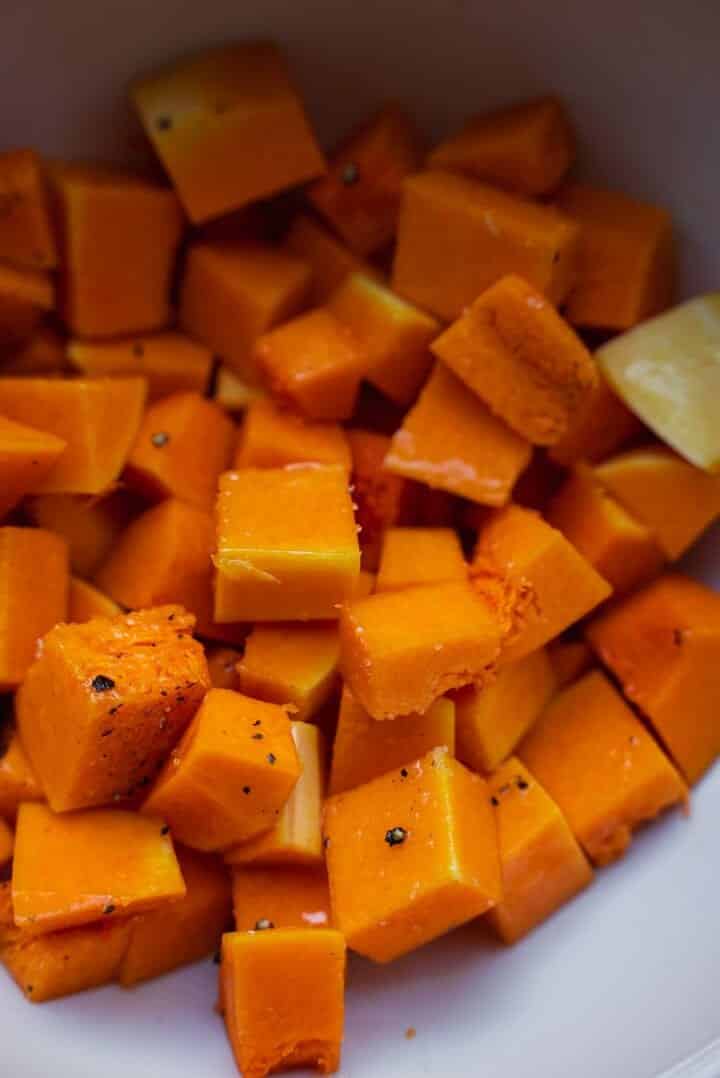
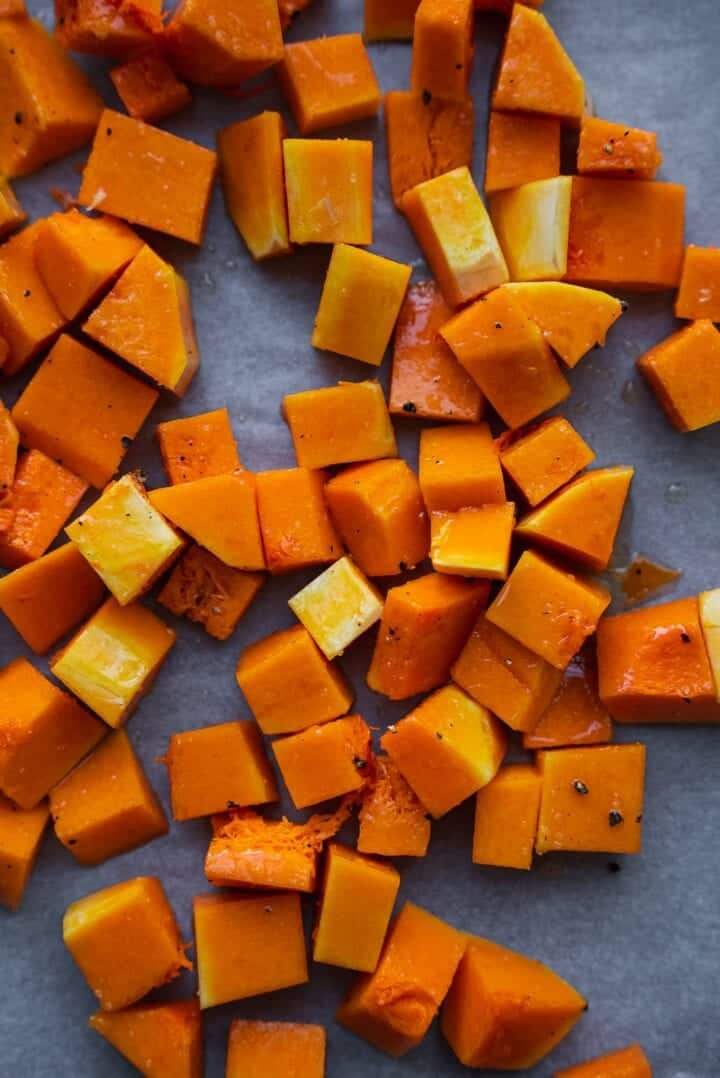
Transfer the butternut squash cubes to a large mixing bowl. Drizzle with olive oil, season with salt and pepper, and mix together thoroughly.
Arrange the butternut squash cubes on the baking tray in a single layer and bake in the preheated oven for 25 minutes, or until fully fork-tender.
Tips and variations
Adjust the seasoning. You can add any other spices of your choice depending on your preference. For instance, add paprika or cayenne pepper for extra spice. Dry herbs such as oregano or thyme will make your kitchen smell amazing!
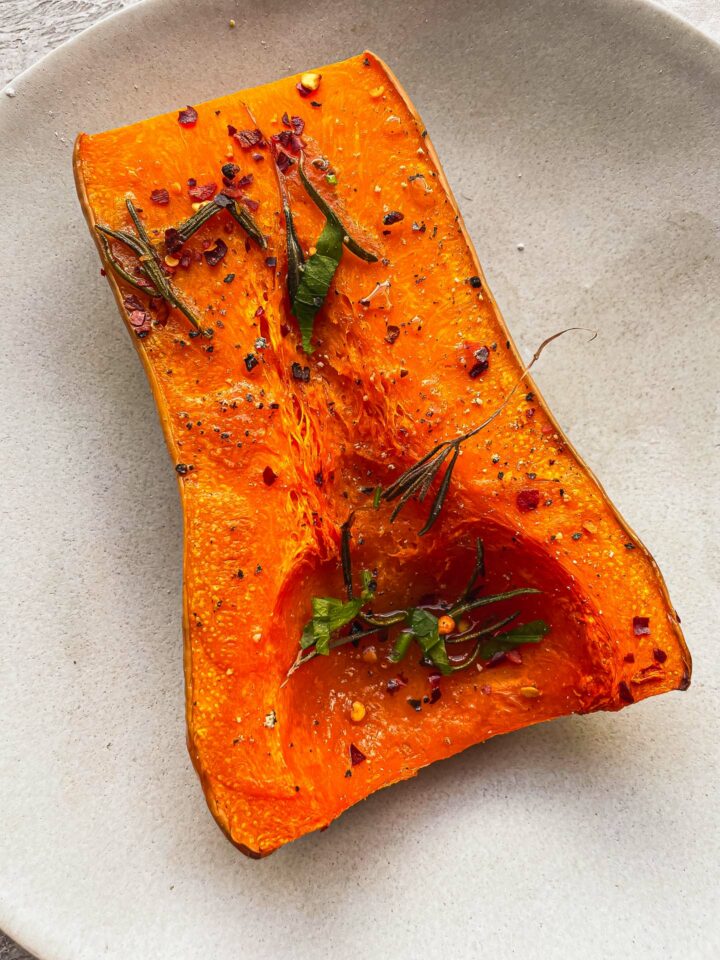
Add sweetness. You can add maple syrup, or sprinkle some coconut sugar before roasting the butternut squash.
Baking time. Keep in mind that the time it will take for the butternut squash to cook through fully will depend on the size/the size of the cubes.
How to store roasted butternut squash
In the fridge: You can keep roasted butternut squash in the fridge for up to 4 days in an airtight container. Eat cold, or reheat in the microwave.
In the freezer: I would not recommend freezing roasted butternut squash. However, you can keep raw butternut squash cubes in the freezer for up to 3 months. Allow to thaw fully before seasoning and baking as normal.
How to serve roasted butternut squash
- As a side dish: baked butternut squash pairs really well with dishes such as tempeh 'ribs', miso-glazed tofu steaks and vegan nut roast.
- In a sauce: you can make a delicious and ‘cheesy’ vegan sauce using roasted butternut squash and make butternut squash pasta! You can then serve it with pasta, as a dip or even as a salad dressing.
- In a salad: mix the roasted butternut squash with any vegetables and grains of your choice for an amazingly wholesome meal. I would recommend using spicy cashew cream as a dressing to level it up even more!
- You can't go wrong with making a spicy butternut squash soup, or a comforting butternut squash risotto.

If you try out making roasted butternut squash, be sure to tag me on Instagram, and leave your feedback in the comments below together with a star rating!
Recipe
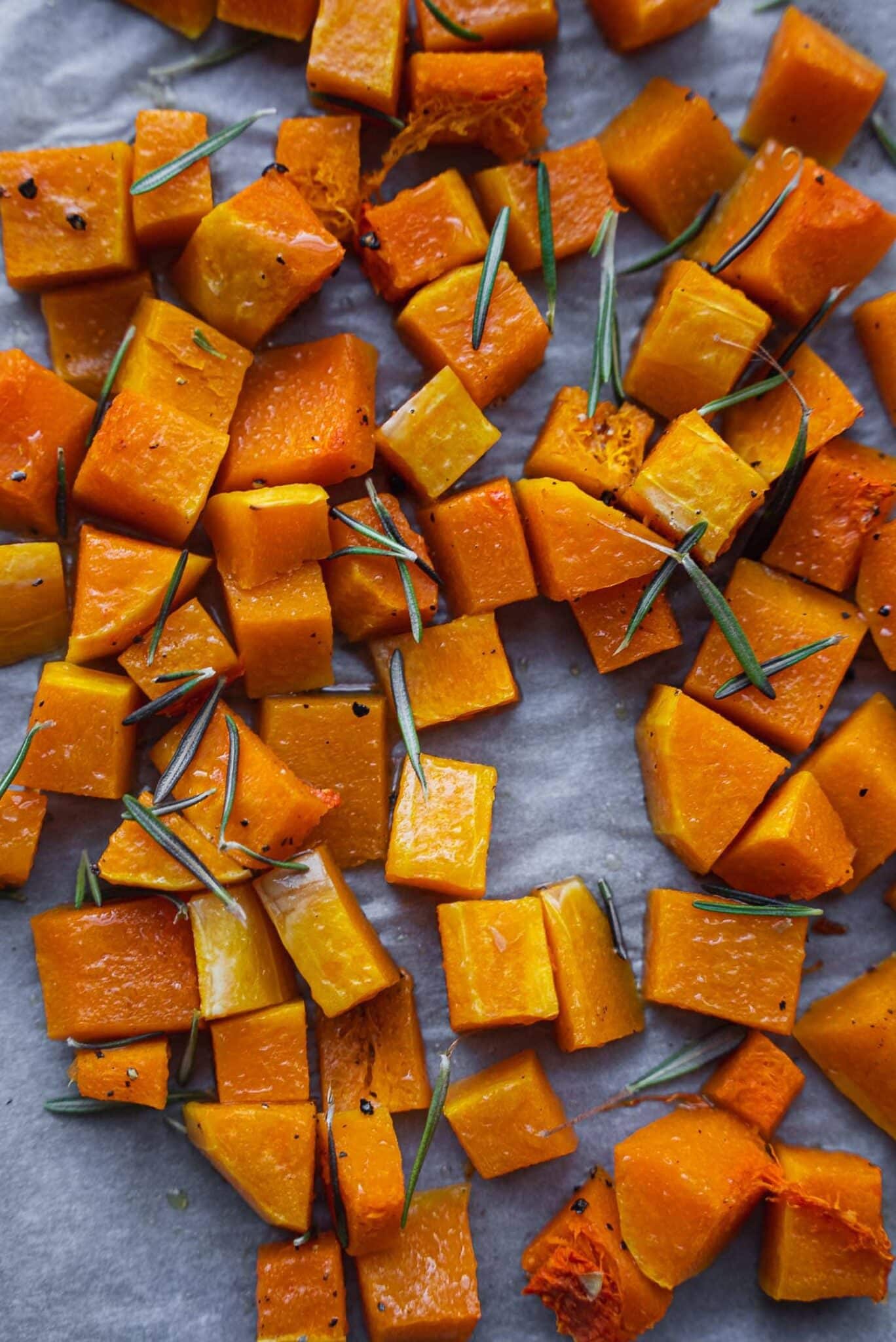
Equipment
- Conventional oven
Ingredients
- 1 large butternut squash (around 4 cups cubed and peeled)
- 2 tbsp olive oil
- ½ tsp salt or to taste
- ½ tsp black pepper or to taste
Instructions
To roast a whole butternut squash
- Preheat a conventional oven to 350 degrees F/400 degrees C and line a large baking tray with parchment paper.
- Cut the butternut squash in half. You can remove the top and bottom to make this easier.1 large butternut squash
- Scoop out the seeds and discard them, or save them for roasting.
- Lay the butternut squash flat side up on the baking tray. Drizzle with olive oil, and season generously with salt and pepper.2 tbsp olive oil, ½ tsp salt, ½ tsp black pepper
- Bake for 50 minutes in the preheated oven, until fully fork tender*.
To roast butternut squash cubes
- Preheat a conventional oven to 350 degrees F/400 degrees C and line a large baking tray with parchment paper
- Remove the top and bottom of the butternut squash. Next, cut it in half horizontally, and then once again vertically.1 large butternut squash
- Remove the seeds from the bottom half of the butternut squash, and discard/save them. Now use either a knife or a vegetable peeler to peel the butternut squash.1 large butternut squash
- Lay each section flat side down, and cut it lengthwise into rectangles. Then, turn them around and cut at a 90 degree angle to make the butternut squash cubes.1 large butternut squash
- Transfer the butternut squash cubes to a large mixing bowl. Drizzle with olive oil, season with salt and pepper, and mix together thoroughly.2 tbsp olive oil, ½ tsp salt, ½ tsp black pepper, 1 large butternut squash
- Arrange the butternut squash cubes on the baking tray in a single layer and bake in the preheated oven for 25 minutes, or until fully fork-tender.


Comments
No Comments